1869-1951
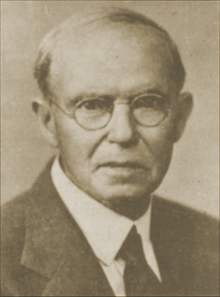
![]()
The Life Of R.L. Whiteside
G.A. Obituary, by C.R. Nichol
R. L. Whiteside, by Don Deffenbaugh
Directions To Grave
![]()
Robertson L. Whiteside, one of the truly great preachers of this century, was born of Luther and Frances Aydelotte Whiteside on the twenty-seventh of December, 1869 in Hickman county in middle Tennessee. The Civil War had ended only a short time before this, and the people of his region had been impoverished by the continual movement of both the Union and Confederate forces through their area. The Whiteside family suffered in this, along with the general population. Eleven children were born to Luther and Frances, and Frances died when R.L. was only twelve years old. We do not have the exact date of his father's death, but do know that R.L. was orphaned fairly early in life. Educational opportunities were limited, even for those with money, but he said that he: "attended school through boyhood three or four months each year, except for two years in his 'teens." At age nineteen he was a student under a noted teacher, R.W. Norwood. In 1890 he was a student in the West Tennessee Christian College, (now Freed-Hardeman,) after this he attended the Nashville Bible school. While at Henderson, G.A. Lewellen was President and A.G. Freed was one of the teachers. Brother Whiteside stayed there only one year, leaving because the Henderson church introduced instrumental music into the worship. Two other young men left with him for the same reason. Unfortunately, we do not have their names. The following year the Nashville Bible School (Now David Lipscomb) was opened and Brother Whiteside was the eleventh to register in the first class of thirty-two. The association here begun with David Lipscomb, James A. Harding and other such men had a profound influence for good throughout his entire life. As all college students do, he also formed lasting friendships with some his own age, including J.N. Armstrong.
An older sister, Martha Jane, in early life had been very helpful to him and others in getting across Swan creek on their way to school. At the death of his parents, she had married and had children of her own, but helped with her brothers and sisters. She had married Jack Sisco, a faithful Christian, who farmed the Whiteside place. Such care produced strong family ties that remained throughout life, and R.L. often arranged to visit them in the summer. A Brother Godwin, an elder in the Salem church, preached often in the Linden-Aetna area, and in October, 1888 when R.L. was eighteen years old held a meeting in the Flatrock church. R. L. was among those baptized. We do not know when he decided to be a gospel preacher, but it was probably about this time. He actually began preaching when he was twenty years old. In the Nashville Bible School he came under the influence of David Lipscomb, an influence that was to remain and bless him throughout life. After moving to Texas, he often returned to Tennessee and following one of these trips made the following report: "While in Tennessee I was in the office of the Gospel Advocate a few times, and saw those grand old soldiers of The Cross, Brother David Lipscomb and Brother E.G. Sewell. Both are growing old and feeble, and will soon join the hosts on the other shore. They have both been towers of strength in The Church, especially in Tennessee. In my estimation Brother Lipscomb is the greatest approach to the ideal Christian that I have ever known."
On February 8, 1893 he was married to Miss Ruth Weatherly, daughter of James and Rebecca Weatherly of Cathey's Creek in nearby Maury county. Ten children were born to them, three of whom were living when this sketch was first published in The Christian Worker in August, 1980. Soon after their marriage they moved to Texas, where several of their relatives had already moved. They settled on a farm in Dallas county, near Cedar Hill and he preached as he had opportunity, averaging about a hundred sermons a year for the first few years. In the years 1893-1900 he kept a record of his preaching work and the support he received. The support was seldom more than the expense of getting to and from the appointment, and was often less. In 1895 he returned to Nashville to get some more schooling. By this time they had two children, and even though Ruth washed and ironed clothes for the students, the financial load was unbearable, and after one year they returned to Texas. In 1902 he began work with the Corsicana church, and continued for nearly seven years. The church prospered under his teaching, and he here began his lifelong work of writing on Bible themes, at first doing most of this work for the Firm Foundation. He became widely and favorably known as a faithful and sound preacher of The Word. Personal modesty kept him from saying much about his own work, so many things about it that we would now like to know cannot now be known. He once gave the following account of the work in general, and remember that this was in the time when the "digressives" were making all kinds of trouble. "Cheering reports come from the field. Congregations are being established, new houses of worship are being erected, and good Christian schools are springing up all over the land. Let us be encouraged. Bright prospects are before us. Thank The Lord. Now let us possess the land."
In 1908 he moved to Abilene to preach for the College Congregation, the only one there at the time, and to teach Bible in the Christian Classical Institute, now, Abilene Christian University. His support was to be twelve dollars and fifty cents per week, but in those days preachers preached to serve and usually expected to make their living "tent-making." A.R. Barnett, the first President of the school resigned to become President of Southland University (Southwestern Christian College) in Denton. After some efforts to find a suitable head for the Abilene school, Brother Whiteside, who was already teaching Bible there, was named President. Due to his favorable and wide acquaintance with the churches in Texas, he was able to keep the school going, but the financial problems of his predecessors became a very difficult task for him. However, in spite of these problems some significant changes were made. Attendance increased and the school began to offer college level work for the first time. There had been a rather "loose arrangement" of a "preacher's meeting," and he sought to improve it by bringing C.R. Nichol and Price Billingsley to the campus for special Bible lectures in the months of January and February. These lectures were a significant step in the development of the present day "Abilene Lectureship."
In 1909 he began a three year program for those who wished to obtain a teacher's certificate, and for the first time the school offered the Bachelor's degree. He was offered the Presidency for the third year, but declined it. After resigning the Presidency, he stayed with the school for some years under James F. Cox and Jesse P. Sewell as a Bible teacher, and served some of the time as Vice President. He found time to continue his preaching and writing, and to the end of his life was glad that he had had a personal involvement in Christian education. A personal letter to Don Morris in 1949, which tells much of his years at Abilene, follows:
"Those were hard years in West Texas. I remember that 1907 was a pretty good crop year, but we had another drought in 1908, and you know that the effects of a bad drought hold on for a long time after the drought is broken. In spite of these difficulties, I remember that we had a total of 160 pupils to enroll during the first year that I was President. In spite of the hard times , the kids loved to sing. It was a singing school then. We had a male quartet in the year of 1909-'10. Claude Sikes, a present faculty member, was one of the four.
I know A.C.C. has good congregational singing now, but it was good then, too. Henry Free was the regular leader, and I believe that he was the best congregational song leader that I ever heard.
Of course I was faced with the same battles that my predecessors had. The only income for teacher's salaries and for our own living was out of tuition. If there weren't enough students, or if they couldn't pay, it was the teachers and the administration who were hurt.
The first year I was President, we could not even guarantee a set salary to the teacher; just say we felt we could pay them a living wage. It was common for me to work from 6 A. M. to 10 p.m. those first months of my tenure, and sometimes I would go without lunch. My wife kept boarders and this paid our food bill. I also preached for the College congregation, and the small salary they paid me was a great help. But times got worse, rather than better, and The Church could no longer pay me a regular salary, but gave me what was left when the incidentals had been paid. Mrs. Whiteside and I had three children in school then, and we were both then, and are now, firm believers in Christian education being the only kind of an education. We had no dormitories for the students then, and of course the students boarded in homes, ours especially. Though there was only one congregation of The Church then in Abilene, the town had grown to the point where it seemed it was time to start another. Brother G. C. Helvy and I rented a sheet iron building over on the South side and helped start another congregation. The students were interested in this project, and were a great help."
In 1914 he moved to Denton, Texas to preach for the Pearl Street church which he served until 1920. Through these years he conducted many gospel meetings, continued his writing, and engaged in a number of debates, both written and oral. From 1926 to 1928 he preached for the Furman Avenue church in Corpus Christi, Texas. Though he was away from Denton, it seemed he always returned there, and it was there in 1930's and 1940's that he did much of the research and writing for which he is now so well known. In the 1930's he did much writing for the Gospel Advocate, first, under the heading, "Doctrinal Discourses," and later as queries Editor. Through many years he prepared much of the Bible school material for the Advocate, often working with H. Leo Boles. Through the years he literally wrote hundreds of articles which were published in the Firm Foundation, the Gospel Advocate, Bible Banner, Gospel Guardian, Christian Preacher, Gospel Guide, Texas Preacher, The Way, and possibly others. He and C. R. Nichol co-authored the first four volumes of Sound Doctrine, a series of Bible lessons that remain useful and popular to this day. He also published a number of books, including: "A Review of the Kingdom of God" by R.H. Boll, "Doctrinal Discourses," "The Kingdom of Promise and Prophecy," "Reflections", and his great "Commentary on Paul's Letter to the Saints in Rome." The Whiteside-Clark debate on the Sunday School question and others. Most of this work is still available. Many of our best Bible students think his Commentary on Romans is the best thing available on this very important book.
Brother Whiteside was a very busy man throughout life. His preaching took him throughout Texas, into New Mexico, Oklahoma, Arkansas, Tennessee, Kentucky, Virginia, West Virginia, Louisiana, Mississippi, Georgia, Alabama, and Florida. All these years he was doing an immense amount of writing and often debating. He lived in a time when The Church had to struggle for every inch gained, and weak preachers simply could not survive. He found time to moderate for Foy E. Wallace, Jr. in all his debates with the pre-millennialists, except the one in California. He once said: "I was born into a fight." He was born soon after the Civil War ended, and much of that strife continued throughout his early life. Religious differences were strong and strict lines were drawn, often with much bitterness. Most Christians of our time cannot conceive of the prejudice and bitterness with which the word "Campbellite" was once freely used, and sometimes still is. Of this and the growth of the New Testament church in the area where he grew up, he once wrote: "In spite of bitter and unreasoning opposition, the number of believers gradually increased. At the age of eighteen I was baptized in Swan Creek by Brown Godwin. I was born into a fight. About a half a mile up the creek was an old Methodist church; beyond that, perhaps a mile and a half, was a Cumberland Presbyterian church; a mile or two beyond that was another Methodist church. Down the other way, less than a quarter of a mile from Salem was a Primitive Baptist church; on a small tributary of Swan was a sort of hybrid Baptist church. About three or four miles down the creek was another Methodist church. It was the farthest away of any of them, but close enough to do some long distance fighting. I think about the time I came on the stage of action, these churches reached their climax of bitterness against us. An old lady said: The Campbellites are worse than the devil. The Bible says, "resist the devil and he will flee from you." "But you resist a Campbellite, and he will flee right at you." "So we had to fight or give up."
Brother Whiteside was a man of strong conviction. While a student under David Lipscomb, he sometimes differed with Brother Lipscomb's interpretation of a passage. Though he respected Brother Lipscomb, perhaps above any man, he did not hesitate to express his views. Brother Lipscomb was also an honest and humble man of conviction, and he was known to abandon his position and adopt that of the student. Brother Whiteside and N.L. Clark were close personal friends, though they differed to the point of public discussion on the Sunday School question. (This debate is still in print.) In spite of this, they remained close friends to the end of life, with Brother Clark often visiting Brother Whiteside after he became ill. Recently, after starting work on this article, I was in a group of preachers, some of whom had known Brother Whiteside personally. I asked them, since I never met him, what kind of a person he was. They all spoke of him in the most complimentary terms, calling him a faithful Christian, an humble man, and a real gentleman in every respect.
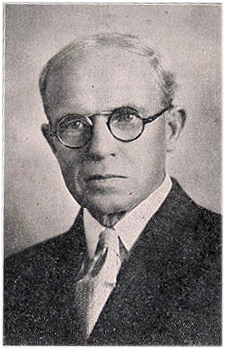
Brother Whiteside's health began to fail in 1944. He went to the Scott-White Clinic in Temple, Texas, where he stayed in the home of Cled Wallace, who was preaching in Temple, while tests were being made. It was learned that he had heart trouble, and from it he never recovered. He was confined to his home, often to his bed, for the rest of the time. He suffered much, but never complained to visitors about his own problems, but talked with them about The Church and its problems. Like the great Apostle Paul, "the care of all the churches" was his constant concern. He continued his writing, often doing so while propped up in bed. Though the physical man grew weaker, the spiritual and mental powers did not fail. Finally, late on Friday afternoon, January 5, 1951, The Lord saw fit to release him from this body of clay. "By reason of strength" he had passed the four score mark in age. On Monday, January 8, the final service was held in the Pearl Street meeting house. A large crowd gathered, including gospel preachers from far and near. Cled and Foy E. Wallace, Jr., along with Hulen Jackson, and perhaps others, conducted the service, and he was laid to rest in the I.O.O.F. cemetery in Denton, Texas. On February 28, 1964 his beloved Ruth followed him into the better world, and she sleeps by his side.
It is difficult to assess the life of any gospel preacher, and certainly that of Brother Whiteside. He was such an unusual man with such a vast knowledge of the Bible, and such ability to reason and think about it. His accomplishments were definitely out of the ordinary. Brother Cled Wallace wrote of him: "He successfully served as President of Abilene Christian College for two years. He ministered to some of the strongest as a preacher, spending five successive years with The Church in Denton, where he lived for many years. He has engaged in a number of oral and written debates, was always confident and at ease and the cause of Christ prospered as a result of each discussion. His deportment has always been that of a gentleman in debate as on all occasions. For a number of years he wrote the Annual Commentary on the Bible school lessons published by the Gospel Advocate. For some ten years he served as Query Editor of the Gospel Advocate, and was otherwise a contributor to that paper. He is a veteran writer and widely recognized as a very able one."
Anyway he is viewed, he was truly one of the greatest gospel preachers of his time. May God bless his memory and his influence that will surely live through his great writing.
-From Gospel Preachers Of Yesteryear, Loyd L. Smith, c.1986, pages 411-417
![]()
Gospel Advocate Obituary
Brother Whiteside Passes
C. R. Nichol
R.L. Whiteside was born in Tennessee on December 27, 1869. He was married to Miss Ruth Weatherly on February 9, 1893. To this union there were born ten children, five living. He died on January 5, 1951. For the past several years he was an invalid.
Brother Whiteside attended, in addition to the public schools in Tennessee, West Tennessee Christian College (now Freed-Hardeman College) for some time, and the Nashville Bible School (now David Lipscomb College) two years. He was connected with Abilene Christian College six years, as president for two years, and the other portion of time as teacher of the Bible and English. For five years he was with the church in Denton, Texas. His home was in Denton for thirty-six years, where he died. One year was spent with the church in Corpus Christi, one year in Beaumont, some months in Louisville, Ky., and McAlester and Bartlesville, Okla.
For years he was query editor of the Gospel Advocate, and also for some years editor of the Annual Lesson Commentary on Bible School Lessons published by the Gospel Advocate Company. Too, he was a writer for years in the Firm Foundation and the papers published by Foy E. Wallace. As a writer, he was one of the outstanding men in the church of Christ, and was appreciated as second to none in the church. His information of the teaching of the Bible was such that he was entirely familiar with any subject he was called on to discuss. He was accurate in statements, and direct in the presentation of the teaching. To students he was one of the most interesting speakers and teachers in the church; to the ones who were seeking entertainment he did not appeal. He was obsessed with the conviction that it was his business as a teacher to present the truth as found in the Bible. He was calm at all times, firm in his convictions, and deliberate in his delivery. As a critic of false doctrine, his statements were withering. He did not engage in as many public debates as some men, but his work in this field was very successful in results, and the cause grew in each place where he debated. His calm, clear presentation of the truth found its way into the hearts of the hearers.
He was co-laborer with the writer in writing a review of the teachings of R. H. Boll's tracts on premillennialism, which has a circulation which has borne fruit. Too, he was co-laborer with me in writing four volumes of "Sound Doctrine," a series of books on Bible studies. This series of books has had, and continues to have, a wide circulation. They deal with the fundamentals of the Bible. His last book, a "Commentary on the Book of Romans," is outstanding and pronounced by many the best commentary ever written on that book. It shows scholarship, close study. One of the most delightful features of the book, in addition to teaching the truth, is that it is couched in language that the ordinary reader grasps, and at the same time appeals to the most profound scholars. Through the years to come R. L. Whiteside will live, and his work will bless thousands.
A friend, true, loved, and gracious. For a number of years I was closely associated with him. From his lips I never heard a word fall that would bring a blush to the face of the most sensitive. He had no place in his life for ugly stories. He had a clean heart; hence, his speech was clean.
I will sorely miss my brother, R. L. Whiteside, a great man, a true man. He lives in my heart and the hearts of many thousands. His life was a blessing.
It is my conviction that among all the women I have known, none have been more faithful to her God, husband, and family than Sister Whiteside. Iniz, the oldest daughter, has proved herself a Heroine through the years of her father's sickness.
-Gospel Advocate, Vol. XCIII, No. 5, February 1, 1951, page 74![]()
RESTORATION LEADERS - R. L. WHITESIDE
Robertson Lafayette Whiteside was born on December 27, 1869 in a log cabin, in the hill country on Swan Creek in Hickman County, Tennessee. This country had been made poor, as had much of the South, by the Civil War. Because of this he was forced to work hard at an early age to help support the family. Hard times often bring with them a maturity that can be gained in no other way. To add to young "Rob's" (Whiteside Bible Dedication) early maturity was the fact that he, at the age of twelve, along with ten other children, was orphaned.
His early formal education was in what was then called subscription schools which lasted two or three months each year. Thus the Blue Backed Speller, McGuffey Readers, and Rays Arithmetic served as the educational foundation for this outstanding student of God's word. There were very few members of the church in the community where Whiteside was born and reared but those few Christians built a meeting house when he was a small boy and called it Salem. There was bitter opposition to the church from the sectarian bodies in the area and Whiteside said he thought that: "About the time I came on the stage of action, these churches reached their climax of bitterness in their fight against us. One old lady said:
The Campbellites are worse than the devil. The Bible says, 'Resist the devil, and he will flee from you;', but you resist a Campbellite, and he'll flee right at you.' So we had to fight or give up. I did not know much about the Bible, but I got a small stiff-back Bible, and worked out a system of chain-reference. In my study I was not hampered by any of these helps in Bible study, nor sermon outline books. I remember distinctly problems I worked out as I rode a mule across the long ridge between Swan and Cathey's Creek. (Whiteside Doctrinal 5)
When "Robert" was eighteen he was baptized in Swan Creek by Brown Goodwin (Curry 87). From that time on he did not turn aside from his resolution to serve the Lord.
The time for more education had come. In 1889 he became a student under R. W. Norwood. In 1890 he began preaching and also became a student at West Tennessee Christian College in Henderson, Tennessee which would later become Freed-Hardeman University. G. A. Lewellen had become president of the school and Whiteside's daughter, Inys, says that A. G. Freed was one of his teachers. There is some question about that, as Freed did not unite his school at Essary Springs with the school at Henderson until 1895 (Young 101). Under Lewellen, little emphasis was placed upon Bible study, although a course was taught for those who wished to become preachers. Also, the Henderson church introduced the mechanical instrument of music in worship about this time. These seemed to be reasons why Whiteside and J. N. Armstrong and one other young man left the school.
Nashville Bible school opened in October 1891 and Whiteside and Armstrong, at least in later years, liked to think they were the first students of the school, for they were standing outside the house that morning in October 1891, waiting for Harding to arrive and open the building." (West 85). His stay here was of a "few months" duration because of a lack of money.
FROM TENNESSEE TO TEXAS
On February 8, 1893, Whiteside married Ruth Weatherly of Cathey's Creek in Maury County, Tennessee. Ten children were born to this union.
Soon after his marriage to Ruth they moved to Texas, following several relatives who had previously moved there. They settled on a farm in Dallas County, near Cedar Hill, and he preached as he had opportunity.
Seeing the need for more education he returned to the Nashville Bible School in 1895 with his wife and two children. His wife washed and ironed clothes for the students to help make ends meet but the financial load was again too heavy and after one year he returned to Texas. He considered David Lipscomb to be the ideal teacher and Christian but he did not always agree with him, especially Lipscomb's view of the Christian's nonparticipation in political matters. Both the student and teacher changed their views about various matters because they could see the other one was right. He was glad for the influence of the men at this school in his life.
In 1902 he began his work for the church in Corsicana, Texas. He preached here for seven years and his fame as a student of God's word and as a preacher and writer spread far and wide. In the book, Gospel Preachers In Texas and Oklahoma, compiled by Mrs. C. R. Nichol, it is said, "R. L. Whiteside is the David Lipscomb of Texas. Truly one of our best men."
During this time he had been doing a lot of writing, especially in the Firm Foundation. It was here he had an exchange with G. W. Savage in 1905-1906 over the work of the evangelist. In 1906-1907 he had a written discussion in this paper with N. S. Clark on the Sunday School question. Later Clark said that the discussion led to "much strife among brethren and perhaps a good deal of personal bitterness that should have never existed" (Casey 4).
PRESIDENT OF CHILDERS CLASSICAL INSTITUTE
Whiteside moved to Abilene, Texas in 1908 to preach for the church there and to teach in the Childers Classical Institute which would later become Abilene Christian University. The next year when Darden, the president of the school, returned to public schools, Whiteside was chosen to serve as president. During the Whiteside presidency, enrollment grew modestly, and with the help of his small preaching income and the fact that his wife kept boarders, he was able to pay his teachers, and keep the school going (Stevens 38).
During Whiteside's administration, the school sponsored a Special Bible Study Week during the first week of January 1910 and again in 1911. These weeks were the forerunners of the lectureship which began in 1918. Whiteside was elected by the board for a third year but later resigned because West Texas was suffering the effects of a drought that was draining the country of money. He stayed on to teach at the school but in 1914 his association with it came to a close because of poor health.
HIS WORK CHANGES DIRECTIONS
In 1914 Whiteside moved his family to Denton, Texas where he worked with the Pearl Street congregation until 1920. When this arrangement came to a close he continued to live in Denton and work with other congregations and conducted gospel meetings around the country. He was living there when he passed away in 1951.
It was during his years at Denton that he did the bulk of his writing. He co-authored with C. R. Nichol four volumes of Sound Doctrine. In 1925 he, along with C. R. Nichol, published the book Christ and His Kingdom: A Review of R. H. Boll. From 1928-1930, he wrote the Adult Quarterly for the Firm Foundation. In 1931 he became a staff writer for the Gospel Advocate and produced a weekly article under the heading of "Doctrinal Discourse." His daughter, Inys, compiled many of his articles in the book Doctrinal Discourses in 1955. From 1933-1936, he was editor of the Gospel Advocate, Adult Quarterly, and prepared material for it. From 1937-1944, he served as editor and prepared material for the Gospel Advocate's Annual Lesson Commentary on Bible School Lessons. Perhaps his greatest work of writing was done in his New Commentary On Paul's Letter to The Saints At Rome. The first edition of this book was presented to the brotherhood in 1945 and was very favorably received. In 1956, Inys published the book The Kingdom of Promise and Prophecy, which was a compilation of articles he had written for various publications. The book Reflections was published by Inys in 1965 and is a systematic arrangement of copy from the Question and Answer department of the Gospel Advocate while he served as Queries Editor for that paper. Inys also published a series of books beginning in 1974 entitled Bible Studies, which is also a compilation of Whiteside's writings. When one looks at the prodigious amount of writing he did, one can only wonder how he found the time to do so much effective work.
In 1944 his health began to fail and a visit to the Scott and White Clinic revealed a serious heart problem. Active work came to an end. However he did continue to write even though he was often confined to bed.
HIS LIFE WORK ENDS
R. L. Whiteside passed away on January 5, 1951, at his home in Denton where he had lived for more than forty years. His services were conducted on January 8 and he was buried in the Denton cemetery.
Loyd L. Smith summarized his life in Gospel Preachers of Yesterday by writing, "Anyway he is viewed, he was truly one of the greatest gospel preachers of his time. May God bless his memory and his influence that will surely live through his great writing."
WORKS CITED
Casey, Michael W., A Family Quarrel Within the Churches of Christ:The Pacifist Tradition of the Non-Sunday School/ One-Cup Churches of Christ. Christian Scholars. ACU: 1997.
Curry, Melvin D., They Being Dead yet Speak, 1981 Florida College Annual Lectures, "Robertson Lafayette Whiteside: Bible Student Par Excellence," Almon L. Williams. Temple Terrace, FL: 1981.
Nichols, Mrs. C. R., Gospel Preachers in Texas and Oklahoma. Clifton, TX: 1911.
Smith, Loyd L., Gospel Preachers of Yesteryear. Allen, TX: 1986.
Stevens, John C., No Ordinary University. Abilene, TX: Abilene University Press, 1998.
West, Earl Irvin, The Search For The Ancient Order. Vol. 4. Germantown, TN: 1987.
Whiteside, Inys. Bible Studies, Genesis-Deuteronomy. Denton, TX: 1974.
Whiteside, Inys. Doctrinal Discourses. Denton, TX: 1955.
Young, Norvel. A History of Christian Colleges. Kansas City, MO: The Old Paths Book Club, 1949.
-2000 Freed-Hardeman University Lectures, by Don Deffenbaugh, pages 54-58
![]()
Signature of R.L Whiteside
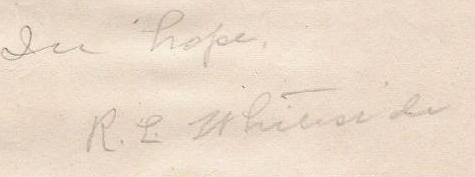
Signature of R.L. Whiteside
Courtesy Of Terry J. Gardner 04.2010
![]()
Firm Foundation Obituary
![]()
Directions To The Grave Of R.L. Whiteside
R.L.
& Ruth Whiteside are buried in the I.O.O.F. (Interternational Order
Of Odd Fellows) Cemetery, in Denton, Texas.
From Dallas, Texas: Heading northwest from Dallas
to Denton on I-35 take exit 465B (Hwy. 377) and turn right. As you head
north toward the city of Denton about one mile you will bear to the left
on S. Carroll. Going one block you will cross Eagle Dr. and see the cemetery on
your left. Enter the cemetery to your left. Then turn left and
From Fort Worth, Texas: Head north on I-35W toward Denton. Take exit 469, (Hwy. 380) and turn right (East) on 380. Travel into town and go to where Hwy. 377 (Elm St.) intersects and turn south. At the south end of town you will turn right on Eagle Dr. You will see the cemetery on the right. Turn right on S. Carroll and enter the cemetery to your left. Then turn left and proceed to the SW corner of the cemetery where you see the corner fence. The pictures below will show how close the grave is to the fence.
GPS Coordinates
33°12'24.1"N 97°08'24.6"W
or D.d. 33.206689,-97.140172
Plot Locaton
Section N, 8 1/2
![]()

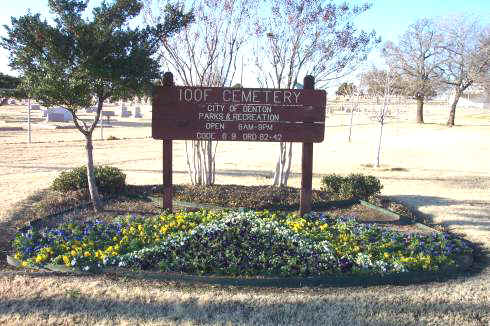
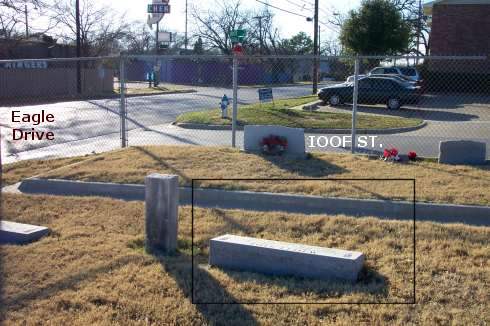
Grave Located At SW Cnr. Of Cem. Next To Cnr. Of
IOOF St. & Eagle Dr.
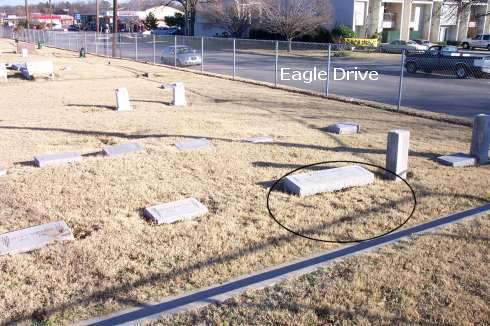
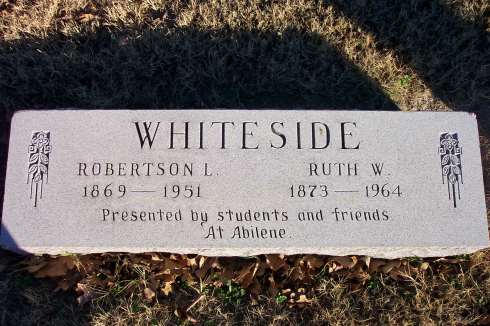
Whiteside
Ruth W. 1873-1964
Robertson L. 1869-1951
Presented by students and friends At Abilene
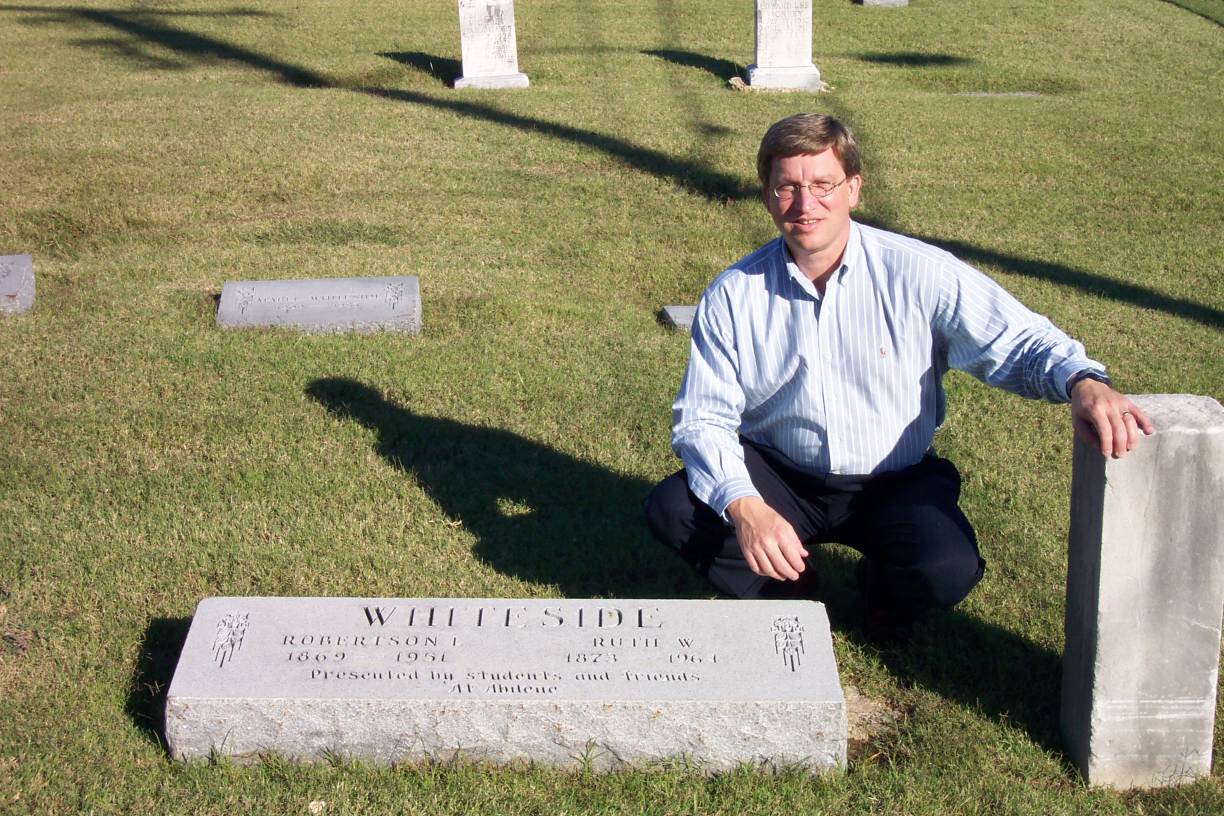
Jeff A. Jenkins At The Grave Of R.L. Whiteside - September, 2005
![]()
